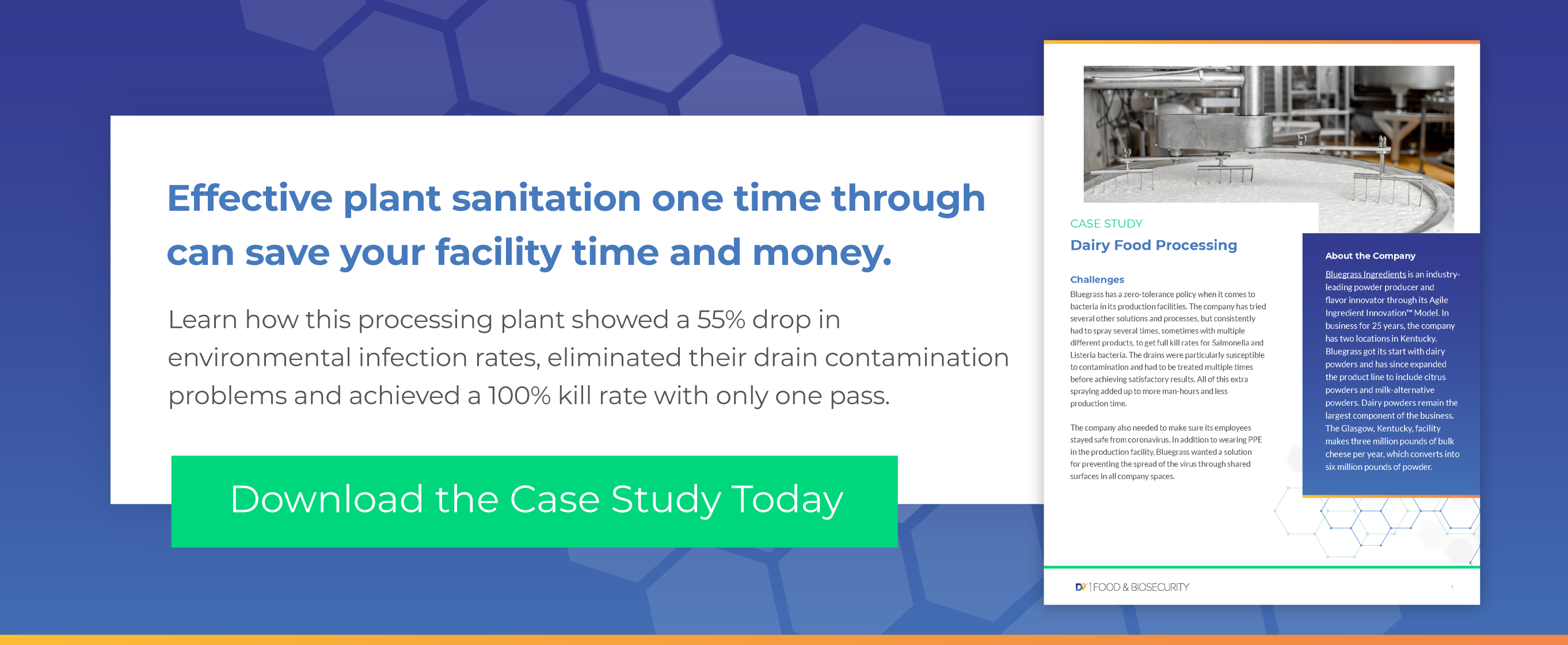.png?width=1160&name=Decon7%20Blog%20%23126%20(1).png) Although bacteria indeed thrive in wet or humid environments, they can also grow in dry conditions. Once introduced, bacteria and mold can continue to grow if they are not properly treated with a sanitizer or disinfectant.
Although bacteria indeed thrive in wet or humid environments, they can also grow in dry conditions. Once introduced, bacteria and mold can continue to grow if they are not properly treated with a sanitizer or disinfectant.
Food processing facilities must be vigilant in preventing food contamination, but the methods are not universal. Dry bakeries are one example of food processing facilities that require specialized techniques for sanitation.
Bacteria and Mold in Dry Processing Facilities
In many food processing environments, water is a key element in the cleaning and sanitation process. It’s used to remove gross debris, dilute and apply chemicals, and rinse. However, dry processing facilities rarely use water for cleaning and sanitation. They need the surfaces to remain as dry as possible because the products are highly susceptible to mold.
Because of this, most dry processing facilities primarily use dry cleaning processes, with the occasional wet clean as needed. Dry cleaning processes include:
-
- Vacuuming
- Blasting dry ice
- Using high-pressure air
- Wiping with alcohol or chemical wipes
Unfortunately, because it’s assumed that a dry environment doesn’t lead to the growth of bacteria or mold, these facilities may not receive cleaning as often as needed. Although dry surfaces are less appealing to most pathogens, humidity in the air can contribute to mold growth, affect product shelf life, and contaminate food.
5 Ways to Avoid Food Contamination in Dry Bakeries
Dry bakeries follow the same seven steps of sanitation as other food processing facilities, but some of the steps are modified to keep surfaces dry. To get the most out of your sanitation processes, follow these five tips:
1. Be proactive.
Perform daily dry sanitation just as you would do wet cleaning in any food processing environment. Create a sanitation schedule that includes deep cleanings to ensure bacteria and mold are not allowed to linger. Having scheduled deep cleanings is especially important to avoid wet sanitation as much as possible. You should also periodically test surfaces for contamination to determine if treatment is required between scheduled deep cleans.
2. Clean equipment outside of the dry area.
When cleaning equipment, disassemble it and transfer any removable parts to another area where they can be cleaned, sanitized, and dried. Sanitize any stationary parts while the equipment is disassembled and ensure that all surfaces are dry before reassembly. This reduces moisture in the dry area while still allowing you to deep clean equipment as needed.
3. Use the right products.
Ensure that any products used are EPA-registered and applied per the label directions. Granular products for entryways can prevent cross-contamination from foot traffic without introducing moisture. Using a fast-drying sanitizer like alcohol to wipe down surfaces and equipment also keeps surfaces dry and humidity out of the air. For deep cleaning, use a sanitizing product that can reach all of the areas that might be missed during dry cleaning, including in unseen crevices, behind equipment, inside drains, and so on.
4. Perform a risk assessment.
Do a risk assessment to determine the appropriate level of cleanliness required for the specific application. This will depend on the type of food being processed, its label claims (e.g., gluten-free, allergen-free), the processing conditions, and the associated food safety risks. Understand that some dry processes, such as seasonings and coatings, are performed in hygroscopic conditions that contribute to mold growth, so wet cleaning might always be recommended.
5. Limit the introduction of water.
Although wet cleaning may occasionally be required, limit water in a dry environment to reduce the risk of mold growth. When wet cleaning is used, ensure that the space is returned to a dry state before production begins again.
Decon7 Is Here to Help
Decon7 products are used in dry processing facilities of all types to control mold growth and food contamination. Because we know how challenging it can be to introduce new products and processes, our team is here to help. We can come to your site to do a product demonstration, work with your team to identify the most appropriate products, provide training to your staff, and be there for ongoing support when questions arise.
To learn about D7 in action, read our recent case study about a dairy processing plant that successfully reduced its environmental infection rate by 55 percent.


